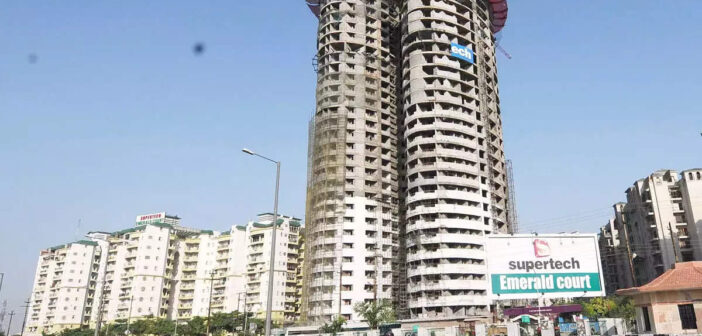The Supreme Court order to demolish the twin towers at Supertech Emerald Court has been widely hailed by the home buyers, consumer rights activists and the media. The reaction on the other side of the fence – the built environment of the real estate – is, however, guarded with caution.
The narrative of the larger stakeholders is that the malaise has been a pre-RERA reality and much water has flown since then. It is being advocated that the Supreme Court order would set a precedent and such violations won’t be a market reality in future.
The larger question, however, is whether the Supreme Court demolition order would actually set the precedent. Would the apex court order act as a deterrent in future? Whether this would be a one-off judgment and the industry won’t mend its ways in future as well? There are more questions than answers as far as the demolition order acting as a deterrence in future is concerned.
A closer look at the way the sector operates indicates that the ground realities are different than what is being anticipated post this historic judgment. The Supreme Court order has hence raised more questions than settled the answers that could goad the sector to best practices in the business. The court order touches upon some of the grey areas like “long & expensive legal battle” that the buyers have to go through. It nevertheless doesn’t offer any solution for the same. The fact remains that the long & expensive legal battle is the primary cause of home buyers’ suffering in silence at the hands of the builders.
There are many instances, particularly in the Delhi-NCR region, where the builder has made changes in the FAR/Lay Out unilaterally at his will. The buyers are later coerced to sign on the consent at the time of possession or else handover is delayed. Since the majority of the home buyers are under the dual burden of both the rent and the EMI, they resign to the builders’ arm twist. The builder hence gets the consent of the two third of the buyers before any victim buyer could drag him to the court.
The Supreme Court order against Supertech hence is a one-off case and it will only make the builders more careful in devising new industry-reality methods in the future to dodge the due process of law. The real question today is that even when this is a landmark judgment, has it settled the grey areas that could change the eco system of real estate in this part of the world. Unfortunately No!
It is because the real pain points of the sector have not been addressed. There are three major pain points that make the home buyers’ bleed in the Indian housing market. Unless these three deep bruises are not cured the real estate will continue to be the business where more than the Indian Penal Code what is applicable is the Builder Penal Code to decide the fate of the home buyers.
First pain point is that there is no entry barrier in the business of Indian real estate. It is still a safe haven of the cartel of black money that invites all shady operators in its fold. Anyone with a financial backing and without credentials can get into the business of real estate without the previous execution capabilities. RERA that was supposed to act as an entry barrier has failed to tame the builders; it’s orders are not even being executed.
The issue of RERA ineffectiveness and layers of legal windows to lengthen the battle of harassed home buyers also brings to the fore the second pain point. There is no fast track court to settle the real estate disputes even when property disputes are nearly two thirds of the consumer grievances in India. The Supreme Court has rightly pointed out that the buyers are being pushed to the lengthy & expensive legal battle. Unless there are fast track courts to settle the real estate disputes, the builders will continue to have the upper hand.
Third pain point is that real estate, life’s costliest purchase for the home buyers, is sold when the product is not even ready. The buyer has no choice but to buy a promise rather than product. What makes the case of property even more painful is the fact that the promise of property delivery comes without any sovereign guarantee. The government agencies and the banks & financial institutions that approve the project wash their hands when there are delays & defaults. They are not even accountable to the real estate regulator.
The Supreme Court has taken a stern view against Noida Authority in this case. But the larger question is about fixing accountability and culpability. Will the heads roll in Noida Authority this time? Will the Supreme Court take Suo Moto cognizance of non-compliance of its order if no action is taken against the officials who colluded with the builder to give sanction in violation of its own prescribed norms? These are the real questions that would define whether the one-off landmark judgment of the apex court would change the eco system of arguably the most corrupt & collusive eco system of real estate in this part of the world.
If the property is sold without any accountability then it has to be sold with the “Build & Sale” model rather than “Sale & Build” model. After all, a vast majority of the real estate defaults are due to fiscal mismanagement of the builders. If a home buyer is buying when the product is ready then he can evaluate the product before making a purchase decision.
The Supreme Court judgment against Supertech to demolish illegal towers would definitely be referred to in the future litigations. It would also make rounds in the academic discussion as to what is wrong with the sector. Unfortunately, it doesn’t promise to set the wrongs as rights. It doesn’t promise to address the real pain points and change the eco system of arguably India’s most high value & yet shady business of builders.
Ravi Sinha
@RaviTrack2media
Track2Realty is an independent media group managed by a consortium of journalists. Starting as the first e-newspaper in the Indian real estate sector in 2011, the group has today evolved as a think-tank on the sector with specialized research reports and rating & ranking. We are editorially independent and free from commercial bias and/or influenced by investors or shareholders. Our editorial team has no clash of interest in practicing high quality journalism that is free, frank & fearless.
Subscribe our YouTube Channel @ https://bit.ly/2tDugGl





